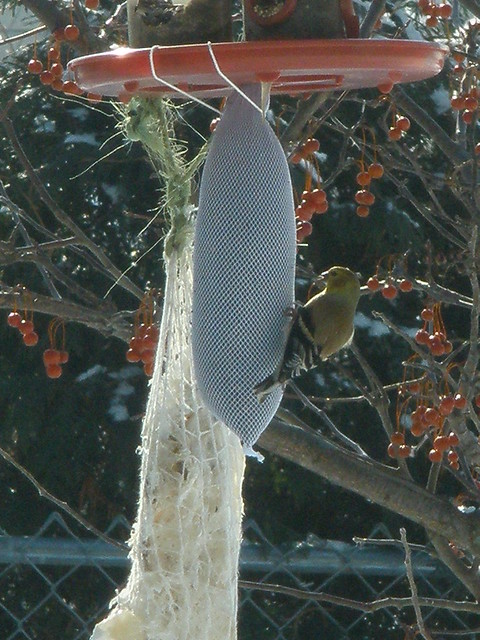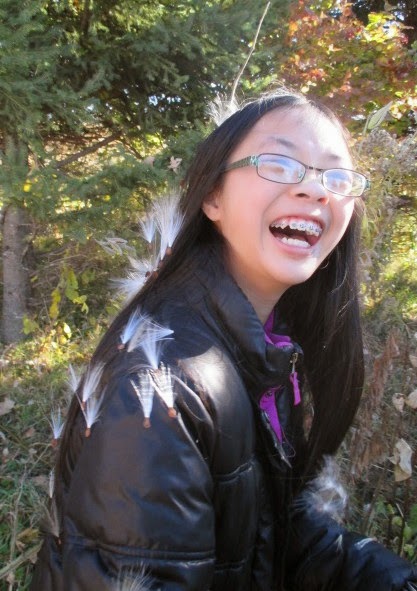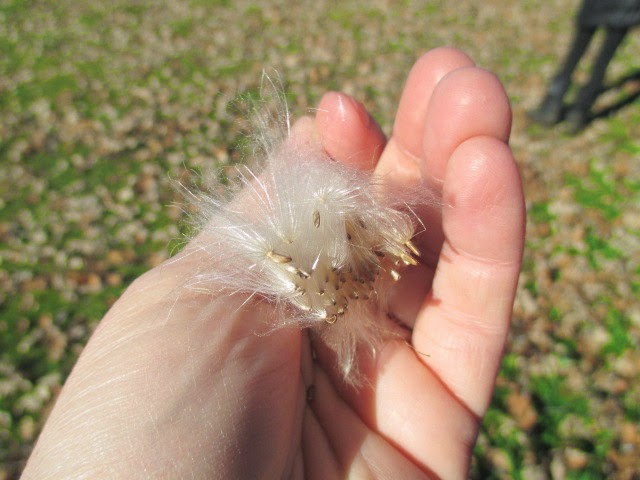Thistle during the summer.
In researching information about the thistle, we stumbled upon a site that said the Thistle is Scotland's national emblem. According to Scottish at Heart:
The Scottish Thistle is the oldest recorded 'National Flower' and is probably one of the most well-known, and easily recognized symbols of Scotland.
But although it may look familiar, you probably don't know the legends that surround it's adoption as a national Scottish emblem.
A humble weed might seem an odd symbolic choice, but really what could be better than a native-born plant which is as bold as it is beautiful?
There's a rich history and several legends surrounding the thistle, and we'll take a closer look at some of it right here.
This resilient little weed has always bloomed across Scotland's landscape, but it wasn't until the 13th century that its place in the country's symbolism and written history began.
One of the best-known thistle legends takes place in the mid-13th century during a surprise invasion by the soldiers of the Norse king, Haakon, at Largs one of northern Scotland's coastal towns.
The story has it that after coming ashore, this Viking force planned to creep up on the Scottish Clansmen and Highlanders and overcome them while they slept.
This amount of stealth required that they go barefoot - which proved to be their undoing.
Unfortunately for these unwary invaders, one of their soldiers bare feet came down hard on a Scottish thistle and his cries of shock and pain were enough to wake the sleeping Scots.
Leaping to their feet, the clansmen charged into battle and the rest, as they say, is history... and yes, the fiery Scots were victorious.
Legend has it that because of the heroic role the plant played in the outcome of the battle, the thistle was immediately chosen as a national emblem.
There are seven different types of thistle that grow in Minnesota. The Friends of Eloise Butler have an interesting chart that compares the seven thistle varieties. The three that have links (Canada, Field, and Bull) look very similar to one another, and we're not sure what variety is growing in the pastures.
There are other links about Common Thistle and Canada Thistle that have range maps to determine what type of thistle is more common in what part of the United States and Canada.
It seems like the way to prevent the weeds from spreading are to cut them at the root - right above the ground - repeatedly so that the plants can't seed. Also, if the ground is tilled and the plants made into smaller parts, the roots still can grow...and not just from one end: from both ends!
Root system of thistle.
The stem of the thistle plant is strong and woody and is covered with pricky leaf stems. The dark, green leaves are placed alternately on the stem and have rough and bristling hairs. There are spines that grow on the edges of the leaves which make them difficult to handle with and without gloves.
The thistle flowers are purple in color and very fragrant. the Handbook of Nature Study notes that "of the individual flowers in the head, those of the outer rows first mature and their pistils protrude; the pollen grains are white."
Since thistle - a weed - is an unwelcome plant in our pastures and takes valuable space away from grass for the horses, we were curious if it had any beneficial purposes. Indeed it does. The seeds are an important food for goldfinches as well as other types of finches. The foliage is used as a food by over 20 species of butterflies, including the Painted Lady butterfly which is common in Minnesota.
The Handbook of Nature Study states that "Butterflies of many species, moths, beetles, and bees - especially the bumblebees - are the happy guests of the thistle blooms."
The thistle plants are prolific seed bearers. "A single head of the lance-leaved thistle has been known to have 116 seeds."
A goldfinch at one of our thistle feeders.
Taken on February 13, 2010.
In addition to being beneficial to birds and insects, according to Wikipedia, the roots are edible and can be consumed by people. However, they are rarely used because many people's digestive system cannot tolerate them. The leaves are also edible, though the spines make their preparation for food too tedious to be worthwhile. The stalks are edible and more easily de-spined. Out of all the parts of the thistle plant, the taproot is considered the most nutritious.
We watched two videos on YouTube. One video was about Bull Thistle and the other video was about Canada Thistle.
"On looking at the thistle from its own standpoint,
we must acknowledge it to be a beautiful and wonderful plant.
It is like a knight of old encased in armor and with lance set, read for the frey.”
Handbook of Nature Study
The girls worked on their nature journals.
Sophia's nature journal entry.
They incorporated facts they learned about as well as traced an outline of thistle and colored it in.
Olivia's nature journal entry.
After we spent time learning about thistle, we spent some times outdoors looking for thistles and observing the changing landscape.
The milkweed now is in the stage of seed dispersal.
The milkweed pods are open, revealing seeds
ready to be dispersed by the wind.
Bailey was relaxing in the sun. She was enjoying the warmth of the sun on her body.
Bailey resting in the sun.
Her dark fur absorbs and retains so much heat
which is welcome on cooler mornings.
The girls had fun taking milkweed seeds and tossing them in the air. The wind gently carried the seeds away.
Sophia watching the milkweed seeds float away.
We didn't notice any thistle in the backyard which is good. However, the minute we got into the east pasture, thistle was evident. The first area we looked at was near the compost pile.
Thistle that is dried.
The seeds are eager to be dispersed.
We are not so eager to see it spread.
As we looked at the thistle, we realized that we should really cut all these tops off so that more thistle doesn't grow next spring.
With 100+ seeds per seed head,
the potential for this weed to spread is huge.
The stem and leaves have prickly edges.
This is a highly uncomfortable weed to touch.
Even dried, the stems and leaves look painful.
Such an unfriendly looking plant.
We explored the east pasture. Much of the ground is covered with leaves.
Such a change from a couple weeks ago.
It definitely looks like autumn.
There is a lot of milkweed in the pasture because we spread the seeds each fall.
The girls helped the milkweed spread by
releasing the seeds in the wind.
The milkweed that doesn't receive the girls' help drop the seeds to the ground.
One milkweed plant dropped many of its seeds to the ground.
Sophia and Olivia enjoyed putting the milkweed on us all so that we would carry the seeds around and they would randomly drop off.
Olivia covered with milkweed seeds.
As we walked back towards the barn, Olivia said, "It's raining leaves!" And indeed it was. The oak tree's leaves were falling gently down as the wind rustled through the branches.
One of the oak trees in the east pasture.
The leaves were so beautiful against the cloudless sky.
Looking up at the oak tree.
We noticed as we were walking that the thistle was throughout the pasture. We stopped at one and took the fuzzy top off the top of one stem. At the base of each one there was a seed. It reminded us of milkweed and dandelions.
Many seeds from just one tiny part of a thistle plant.
Bailey was curious to see what we were doing.
Stopping for a moment to enjoy the weather.
The thistle plant is clearly an unfriendly plant. It has sharp edges all over it.
Close up of a thistle plant.
The downy part of the thistle is incredible soft.
The seeds are attached to a very soft, downy silk.
It was amazing to see how many seeds were in such a small area.
As we were in the east pasture, Olivia spotted the bluebirds that were going in and out of the bluebird house that we built in 2013.
One of the bluebirds is sitting on the post.
The bluebirds flew away and settled in nearby trees. It gave us a chance to look at the birdhouse.
There was an empty nest in the bluebird house.
Looks like we need to do a bit of repair work on the roof.
The birds watched us as we were exploring the house. Hopefully they return next year and use the birdhouse to raise their young.
This bluebird was sitting in a tree.
We found a burdock plant that still had purple color on it. It resembles the thistle plant in color, but has burs on the top instead of the downy seeds that disperse by the wind.
Burdock that still has some purple color to it.
It is similar to the color of thistle.
We enjoyed our walk outside, and were happy to explore the pasture looking for thistle. So many changes are happening each week. Going outside regularly helps us document these changes.
We used OHC More Nature Study #9 Thistles and Thistles - Starting a Year Long Study on the Outdoor Hour Challenge as inspiration.




























2 comments:
Those plants with thistles and burrs and stickers are smart, but not animal friendly--including humans. The insects appreciate them more, I think. ;)
I love how soft milkweed seeds are. The thistles are hard to touch but I really enjoy the purple flowers in the summertime. Thanks again for sharing your entries with the OHC Blog Carnival.
Post a Comment